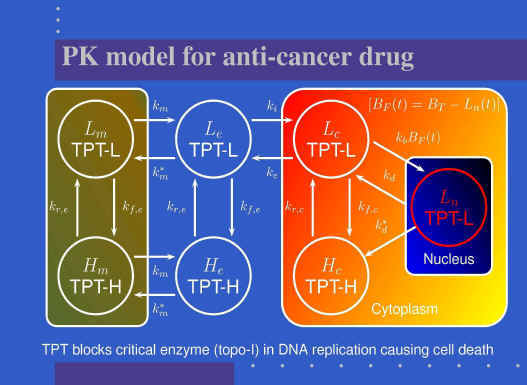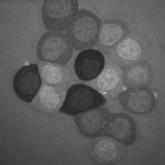Simulation of a mathematical model for an anti-cancer drug
In collaboration with the Department of Biochemistry and the Department of Pathology, University of Wales College of Medicine.
This work aims to develop integrated mathematical models for pharmacokinetics and pharmacodynamics that demand innovative biotechnological and mathematical solutions. The project addresses single cell drug responses in heterogeneous and dynamic cell populations. The work has widespread application in predictive biomedicine and in silico drug screening. The focus will be on the biology of drug targeting and its link with perturbation of the mammalian cell cycle using novel live-cell behaviour and protein-tracking methods together with mathematical models. The biotechnology will support the derivation of the non-linear models that present significant challenges for structural identifiability.
Topotecan (TPT) is a new anti-cancer drug, currently in multiple clinical trials, that must interact with the cellular DNA to be effective. Recent evidence suggests that only TPT bound to DNA causes the biological effects of interest in the treatment of tumours, and that TPT is degraded into an inactive form under physiological pH conditions. In a previous study, the action of the drug after administration has been described with mathematical equations ( a system of ordinary differential equations). In this project software has been developed for simulating this mathematical model for TPT.
Video showing the uptake and delivery of Topotecan
into single cells. Highlighted are three regions: a low loading cell
(yellow), a low loading cell (orange) and a medium
compartment (red sqaure).
The simulation software enables experimentalists to follow changes in drug activity after administration, and the delivery of the drug to nuclear DNA under the physiological conditions found in human tumours. A valuable tool is then provided for investigating DNA binding, to evaluate the effects of different levels of initial dose of the drug, and to explore drug-resistance in tumours.
The software also assists in the validation of the mathematical model, using experimental data, with the final objective of enabling clinicians to explore, and predict, TPT action in practice.

A timelapsed video of typical human
breast tumour cells (MCF-7 cells)
growing in a tissue culture environment
An image showing MCF-7 cells loaded with Topotecan after 10 minutes. This shows heterogeneity
and a pattern of drug in the nuclear environment.

